Menus
- Some subtle changes for the 2018 version of the trail
- In-line twin, 998 cm3, 95 hp at 7,500 rpm, 98 Nm at 6,000 rpm, from 237 kilos, from 13,549 €
- Discovery
- In the saddle
- Engine and transmission
- Road behavior
- Part-cycle
- Brakes
- Conclusion
- Video test of the 2018 Honda Africa Twin
Some subtle changes for the 2018 version of the trail
In-line twin, 998 cm3, 95 hp at 7,500 rpm, 98 Nm at 6,000 rpm, from 237 kilos, from 13,549 €
The bet was daring…. and it has been crowned with success: while the large trails segment is booming, while all manufacturers want to steal market share from BMW and, for this, copy the recipes of the German manufacturer and try to differentiate themselves in an upgrade in power and technology, Honda, with its CRF 1000 L Africa Twin presented two years ago, has not been tempted to show off its power as the world’s leading manufacturer by performing even more efficiently than the others, but, on the contrary, presented a machine on a human scale, whether in its dimensions, which were not going to flirt with those of a supertanker (friendly nod to the Ducati Multistrada 1200 Enduro, BMW R 1200 GS Adventure and Triumph Tiger 1200), or in the behavior of the engine, delivering a power certainly, not overflowing, but not useless either (frankly, who – really – needs a trail of more than 150 horses?).
In two years, more than 51,000 copies of the Africa Twin have been sold, among them no less than 25,000 in Europe and more than 4,300 in France. Not bad is not it ?
As the career of the Africa Twin is still quite short, the 2018 vintage sees two novelties: the Adventure Sports version, already tested on Le Repaire and the standard version, which is improving in subtlety.

Also, in order not to repeat already written essays, very complete and which are available here on the Den:
- the first test of the Africa Twin in South Africa
- a comparison of the Africa Twin 1000 and its inspiration, the Africa Twin 750
- an off-road test of the Africa Twin in the muddy forests of Wales.
…. we will only treat this novelty from the point of view of the improvements it incorporates and the benefits that this brings to its happy owner. Straight to the point, therefore.
Discovery
The tricolor versions, whether predominantly white or red (and which also require a price supplement of € 300), are renewed. Two new colors are appearing: a candy red, dark and quite classy, as well as our test copy, a mat black with "sand" trims which, by the general opinion, suits it quite well. The surface treatment of the fork has also changed.
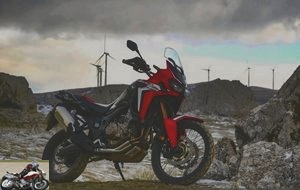
We also discover a new gas handle: rest assured, it is still rubber, it is still rotating and it is always placed on the right. The fundamentals are respected. The difference, however, is that it no longer controls a good old cable, like the Monet-Goyons. No, now it’s an avalanche of bits and codes 0-1-0-1: acceleration is thus entrusted to a modern electronic ride-by-wire system, which allows Honda to fine-tune its electronic aids. We now have four driving modes: road, urban and off-road, plus a personal mode that allows you to go into details and select your preferences among three power levels, three engine braking levels and seven levels of anti-slip (in addition to the total disconnection of this aid).
For this, we realize that the dashboard has also evolved, with more information present, but a readability that can be problematic depending on the sunshine or, after a few kilometers on the track, when a thin layer of dust has covered all. Finally, the indicators are automatic return.
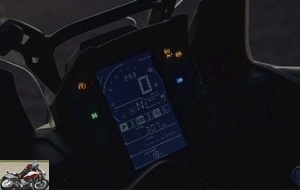
That’s not all: it can’t be seen, but the battery is new. It is more compact, lighter by 2.3 kilos and despite this, its lifespan is quadrupled.
The Adventure Sports version also benefits from all these developments. Finally, we note that despite its power (95 horses) which makes it theoretically restrictable for A2 licenses, Honda does not offer this machine to young licenses. For them, the world’s leading manufacturer recommends the CB 500X.
In the saddle
Having tried the Adventure Sports version the day before with its high perched saddle (900 to 920 mm), the standard Africa Twin appears much easier to grasp, with a saddle adjustable between 850 or 870 mm and a significantly larger fuel tank. end. Also, a wider range of riders will feel more comfortable on board..
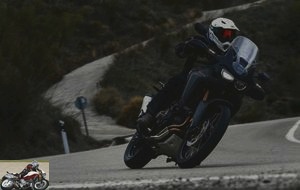
Once on board, you can therefore and this is new, select your driving mode (you have to be at a standstill) or refine your preferences (the level of traction control can be changed while driving, which was not the case with the old version and which could sometimes be handicapping off-road, as we had seen during our test in the mud of Wales). Finally, new footrests, a little wider than before, make off-roading easier.
Engine and transmission
The Africa Twin’s engine does not change much: the modern 998cc vertical twin-cylinder still produces 95 horsepower at 7,500 rpm and 98 Nm at 6,000 rpm. For 2018, the changes are therefore minimal: the exhaust is new, the old one was 4.6 liters with three chambers, the new one is 4 liters with two chambers. The balancing beams are new and their weight has been reduced by 50 grams. Finally, the air box ducts are 20mm longer.

Not enough to revolutionize the model, that’s true. On the other hand, the sound presence has changed, with an exhaust delivering a more distinctive note (it almost looks like a Ducati in certain respects), without however reaching a sound volume that is neither unbearable nor really disturbing. Let’s say it strengthens his personality ….
The great strength of the Africa Twin is also its flexibility in the transmission, with the presence of a DCT version alongside a more classic, 6-speed "manual" gearbox. On the other hand, for the latter, a shifter has appeared as an option.
Road behavior
All of these changes don’t really affect the Africa Twin’s handling qualities or character traits. We therefore find an agile machine, extremely well balanced and easy to handle. It steers well in the city, extends its stride on the highway and is very agile on small roads: a beautiful versatility that will delight fans of trail a little old-fashioned, insofar as it is less rigorous than fighter planes. from 1200 and 1300 which squat at the top of the category, that there are a little more marked mass transfers. So what ? The Africa Twin is healthy, holds the road very well and is calibrated enough to go sporty on small roads, whether with the responsiveness of the DCT system (effective in Sport 3 mode when the weather is fine) or, with the shifter. optional manual gearbox. In short, it’s fun and that’s the main thing.
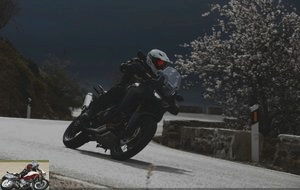
Likewise, if we praise the quality of the suspensions, we can blame, in the long run, a little perfectible protection as well as a saddle that can become a bit rough at the base.
Finally, note that the response to the handle is perfect on all driving modes, with an extremely well calibrated by-wire. Likewise, the ability to change your level of traction control (whose operating mode has been refined, with injection cuts almost three times shorter than before) while driving, is a plus.
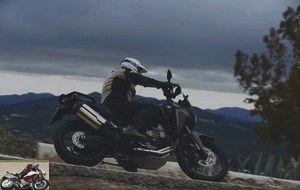
Part-cycle
Here again, the 2016 recipes are carried over: we just note the appearance of new tires, with two possible choices as original equipment, the Dunlop Trailmax 610W, whose behavior in the wet has been improved, or the excellent Bridgetsone Battlax A41. Note also that for TT practitioners, the Continental TKC80 have been approved by Honda.
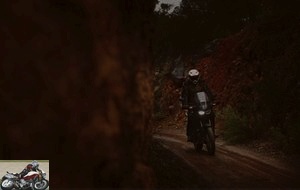
Brakes
The familiar system is renewed, with two 310mm discs up front, clamped by radial 4-piston calipers. Nothing to say about the braking, excellent and nothing to say except that the mass transfers are still quite pronounced. The novelty is that on hard braking, the warnings flash briefly to warn the motorists behind that they must stop consulting their smartphone…. However, the system is quite sensitive and there is no need to stand on the brakes to activate it..
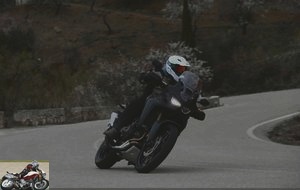
Conclusion
Admittedly, the Adventure Sports version steals the show a bit from the standard Africa Twin. More adventurous, more generous in its size and in its services, it has a "whaouh factor" that the standard model can envy. And it’s not just a show: increased comfort and range, heated grips and generous protection as standard, it will do the job better than the standard model as soon as you seriously want to cut the road. Would it not be and it is far from a detail, a saddle height a little discriminating.
Knowing that the average rider does not set off to the end of the world or even on an adventure every day, the standard Africa Twin returns to the race with a consistency that is really hard to fault. She refuses the arms race and the power race and in everyday use, that’s just perfect, not to mention that it already performs very well for recreation. And it is still worth 1,500 euros less than the higher version. Which of the two versions will suit you best? It’s up to you, especially in terms of price, but still it is that with this pair of motorcycles, Honda has a really tempting offer in the world of trails.
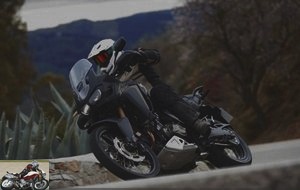
Strong points
- Incredible homogeneity
- Nice engine
- Versatility
- Complete dashboard
- Reasonable size & performance
- Quality of suspensions
Weak points
- Perfectible protection
- Saddle closes in the long run
- Hardly legible dashboard
Honda Africa Twin technical sheet
Test conditions
- Itinerary: a short morning test in the Malaga region
- Motorcycle mileage: 600 km
- Problem encountered: the rain sucks !
The competition: BMW F 850 GS, KTM 1090 Adventure, Triumph Tiger 800
Video test of the 2018 Honda Africa Twin
Related articles
-
Motorcycle comparison BMW 1250 GS / Honda Africa Twin 1100
Potato or mash ? BMW R 1250 GS 136 hp, 143 Nm at 6250 rpm, 249 kg all full, 17,600 euros (21,294 euros for the model tested with Comfort, Dynamic and…
-
Honda Africa Twin Adventure Sports test
Honda returns to the adventurous spirit of the original Africa Twins In-line twin, 998 cm3, 95 hp at 7,500 rpm, 98 Nm at 6,000 rpm, from 243 kilos, from…
-
Honda Africa Twin CRF1100L Adventure Sports motorcycle test
100 hp, 105 Nm at 6,250 rpm, 238 kg all full (250 kg in DCT / EERA), 16,899 euros (19,399 euros in DCT and EERA suspensions). The spirit is there It…
-
4 cylinders in line, 649 cm3, 95 hp at 11,000 rpm, 64 Nm at 8,000 rpm, 208 kilos, from € 7,199 Honda’s mid-size roadster passes Euro 4 standards and gets…
-
Honda renews its big roadster. Retro, sporty, or both ? 4 cylinders in line, 998 cm3, 145 hp at 10,500 rpm, 104 Nm at 8,250 rpm, 212 kilos with full…
-
Honda Africa Twin CRF1000L test
Honda CRF1000L Africa Twin ABS and DCT version Legends never die. Like the phoenix, the Africa Twin is reborn from the sand of its past exploits in a…
-
Ideal motorcycles for beginners, have fun or … have fun Anxious to face the competition and give a makeover to its CB range, Honda offers three new…
-
The latest generation of CB 500s delighted “young licensees” for over a decade. Her replacement was therefore expected at the turn, crystallizing the…
-
Four cylinders in line, 1140 cm3, 90 hp at 7,500 rpm, 91 Nm at 5,500 rpm, 252 kilos, € 12,999 A more sporty version of the neo-retro roadster 2013: in…
-
Honda Africa Twin test in the mud
Three levels of traction control, disconnectable ABS, DCT: useful, or not ? A life-size test at the Honda Adventure Center in Wales A real commercial…